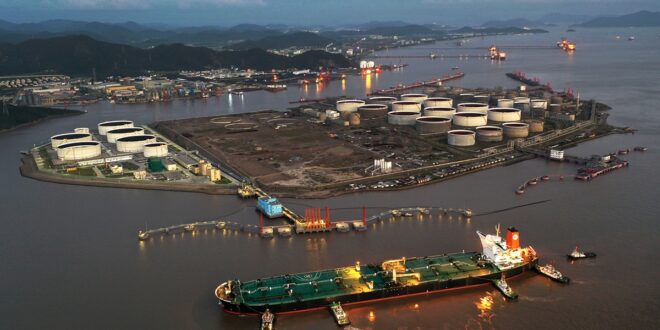Chinese energy commodity imports were underwhelming in the first two months of 2023, but they are expected to pick up later this year with potentially record-high crude oil purchases, even though Beijing has set its lowest annual economic growth target in decades.
In January and February, months in which China reports trade data together to remove distortions around the fluctuating week-long Lunar New Year holiday, Chinese imports of crude oil and natural gas fell compared to 2022. But arrivals of iron ore—the key steel-manufacturing material—jumped as steel mills stocked up in expectation of a government push to boost the economy via infrastructure projects.
Despite weaker crude oil and natural gas imports early into the year and just after the Chinese reopening after nearly three years of strict Covid measures, analysts expect China’s oil imports to accelerate later this year and support global oil demand growth.
China’s crude oil imports averaged 10.4 million barrels per day (bpd) in January and February, down by 1.3% compared to the same months in 2022, according to official Chinese data in tons estimated in barrels by Reuters’ Asia Commodities and Energy Columnist Clyde Russell. The imports were also below the more than 11.3 million bpd in crude imports in November and December last year.
The weaker crude oil import levels could be due, in part, to the Lunar New Year holiday at the end of January and the fact that crude cargoes are typically arranged months ahead of their actual arrival and customs clearance.
“The latest trade data from China shows that crude oil imports in the nation remained weak at the start of the year as refiners eased purchases ahead of the Lunar New Year holiday,” ING strategists Warren Patterson and Ewa Manthey said on Tuesday, commenting on the import data.
“China’s latest oil trade data hints at softer domestic demand which could weigh on sentiment in the short-to-medium term if imports do not recover,” they added.
The economic momentum is expected to accelerate and lift crude oil demand as the year progresses, analysts say. That’s despite the fact that China set this week its lowest annual GDP growth target in decades. China aims for roughly 5% growth this year, lower than last year’s target and at the low end of analyst expectations.
“Looking ahead, China’s crude oil imports could recover over the next quarter as industrial activity picks up and refiners rebuild their stocks,” ING said.
The Chinese reopening and new refineries coming online are set to raise the imports in the world’s top crude oil importer to a record high this year, industry consultants told Reuters last month.
Chinese crude oil imports could increase to an average as high as 11.8 million bpd this year, rising by between 500,000 bpd and 1 million bpd, according to Energy Aspects, FGE, S&P Global Commodity Insights, and Wood Mackenzie.
This would reverse the decline of 2021 and 2022 and beat the record of an average 10.8 million bpd in yearly crude oil imports from 2020.
China’s resurgent oil demand—with growth seen at 900,000 bpd this year—along with demand in the rest of the Asia-Pacific region will dominate global oil demand growth in 2023, the International Energy Agency (IEA) said in its latest Oil Market Report in February.
China’s demand for oil and gas could be one of the biggest annual growth stories, according to Mike Muller, head of Asia at the world’s largest independent oil trader, Vitol.
“Most analysts have been revising their estimates for Chinese oil and gas consumption up, for the balance of this year, which will make 2023 one of the biggest year-on-year demand growth stories that we’ve seen, next to 2001-2002 and 2009,” Muller said on a Gulf Intelligence podcast this week.
According to Victor Yang, senior analyst at JLC Network Technology, it doesn’t matter if China sets its GDP growth target at 5% or 5.5% as “international estimates are showing more optimistic growth.”
“This is because we are now seeing oil demand in China growing significantly,” Yang told Gulf Intelligence this week.
“In February, we imported about 11.8mn bd, a significant jump from the last quarter of last year, and demand is still on the rise.”
China’s demand could be a major bullish factor for the oil market and prices this year, but the latest comments from Federal Reserve Chairman Jerome Powell on Tuesday dampened the bull market story after he said the Fed “would be prepared to increase the pace of rate hikes” if inflation continues to run hot. The market started pricing in again a stronger possibility of a 0.5 percentage point hike later this month.

default
 Iran Energy News Oil, Gas, Petrochemical and Energy Field Specialized Channel
Iran Energy News Oil, Gas, Petrochemical and Energy Field Specialized Channel



